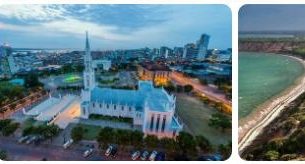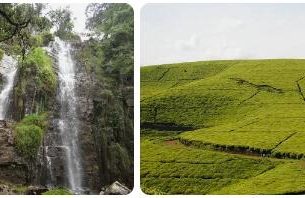Attractions
The Eastern Highlands
The Inyangani, Vumba and Chimanimani mountain ranges are one of the main resort areas in the country. At 2592 m, Inyangani is the highest mountain in Zimbabwe. Deep valleys, gorges, wooded slopes, trout streams and steep cliffs determine the landscape. Tennis, squash, billiards and bocce can also be played in this region. The rolling golf courses are a challenge, while mountaineering and pony trekking are other popular pastimes. If you want, you can try your luck in the casino.
Annotation
For safety reasons, the reserves may not be entered by motorbike.
- Usprivateschoolsfinder: Offers description downloadable image of national flag for the country of Zimbabwe. Also includes prehistory and history of this nation.
Parks and reserves
Parks and reserves cover over 11% (44,688 sq km) of the country’s total area. Zimbabwe has numerous national and amusement parks, several botanical gardens, reserves and safari areas where hunting is permitted (hunting is strictly controlled and the proceeds are intended to benefit the conservation programme). Hwange National Park is Zimbabwe ‘s largest national park at 14,620 sq km. The biodiversity of the animal world is unique. Several roads lead from the park’s three safari camps to the areas where most animals can be seen. High stands have been set up for visitors at some water points. Hwange is one of the last major elephant reserves and herds of elephants come to the waterholes, especially towards the end of the dry season in September.
The world’s largest waterfalls and without a doubt Africa’s greatest natural spectacle, Victoria Falls is 120 km from Hwange National Park. They are 1.7 km wide, and 550 million liters of water fall over 100 m into a narrow gorge every minute. The drizzle can be seen from a distance of 30 km. The best way to appreciate the grandeur of the Victoria Falls is to take a scenic flight in a light aircraft (so-called ‘Angel Flights’ are available) or a boat trip on the wide Zambezi River. You can also cross the border into Zambia without much formality to see the falls from the other side.
At nearby Zambezi National Park, visitors can see sable antelope and other exotic animals.
Zimbabwe’s most beautiful park is the 2196 sq km Mana Pools National Park on the banks of the Zambezi. Much of the park is forested; Hippos, elephants, rhinos, buffalo and many antelope species have found a habitat here. Visitors can track down the animals on foot with binoculars. Countless bird species live in the bush and in the riparian regions. Tigerfish, bream and large vundu are found in the waters. The park is closed from November to March.
In the northwest on the border with Zambia is the 7770 square km large Lake Kariba. Comfortable safari camps, tour boats and safari buses are available to visitors.
A trip to the Zimbabwe ruins of the Great Zimbabwe National Monument, the most important and largest preserved historical site in South Africa is an experience. The ruins are the remnants of a gold trading city-state that flourished in the Middle Ages. The large temple is built of hand-carved stones without the use of mortar. In total, the temple ruins consist of 485,521 cubic meters of masonry. The nearby Gonarezhou National Park is known for its diverse bird life and a number of rare animal species. The park belongs together with the Limpopo National Park in Mozambique and the Kruger National Park in South Africa to the transnational Great Limpopo Transfrontier Park (GLTP) (Internet: www.greatlimpopopark.com ).
Bulawayo is the second largest city in Zimbabwe, a major commercial and industrial center and the headquarters of the National Railways of Zimbabwe. A visit to the National Museum is worthwhile. Not far from the city are the ancient Khami ruins and further south is the Rhodes Matopos National Park with bizarre formations of huge granite boulders. Reservoirs rich in fish, caves with mural paintings and a game reserve make the area one of the most popular excursion destinations.
Harare: The capital of Zimbabwe was formerly called Salisbury and is the commercial and industrial center of the country. For most visitors, Harare is the first stop on their Zimbabwe trip and the starting point for trips to other parts of the country. The modern city has beautiful parks and a modern museum with an art gallery. Other attractions include the Robert McIlwaine Theme Park with lake and wildlife sanctuary, Lion Cheetah Park, home to lions and cheetahs, Larvon Bird Gardens and Ewanrigg Botanical Gardens. Because of its sunny climate, Harare is also nicknamed the “Sunshine City”.
The Highlands
The highlands consist of a chain of low mountains that stretch from the north-east to the south-west in the center of the country. This is the most densely populated area in the country.
Shopping
Overview
10-22% sales tax will be added to all purchases excluding items to be exported. Copperware, wood and soapstone carvings, leather goods, pottery and wicker are all great souvenirs. Shop opening times: Mon-Fri 08:00-17:00, Sat 08:00-13:00.
Nightlife
Introduction
The larger towns have nightclubs, cinemas and theatres, while in smaller towns restaurants and discos often provide the only evening entertainment. There are three casinos in the main resort areas.
Culinary
Overview
Zimbabwe’s restaurants offer specialties of local and international cuisine. Meat dishes are particularly recommended. A traditional dish is sadza (a thick cornmeal porridge) with meat and/or gravy and a dip. Table service is common. Drinks: Light and dark beers are popular. Imported wines, liqueurs and spirits are also available at the hotels. The traditional corn beer Hwahwa is brewed for special occasions. Bars are almost only found in hotels, they are open around the clock. Serving hours are otherwise between 10:30 a.m. and 3:00 p.m. and 4:30 p.m. – 11:00 p.m.
Accommodation
Hotels
There are hotels and lodges (a type of inn that offers bed and breakfast). Foreign visitors must pay in foreign currency. A list of registered hotels is available from the Tourist Office (see addresses). Categories: Hotel categorization according to the 5-star system. Over 70 hotels (with at least one star) are registered with the Tourist Office. Hotel Association address: Hotel and Restaurant Association of Zimbabwe (HARAZ), 9th Floor, Travel Centre, Jason Moyo Avenue, PO Box CY 398, Harare. Tel: (4) 73 32 11. (Web: www.haz.co.
Camping
There are campsites in most resort areas, lodges and cabins are available in the national parks.
Culture
Religion
50% adherents of a mixture of Christianity and native religions, 25% Christians; 24% followers of indigenous religions, 1% Muslim, Jewish and other minorities.
Social Rules of Conduct
The British influence is very noticeable in the cities, while the old traditions and traditional crafts have been preserved in rural areas. They shake hands to greet each other. With invitations to private houses, the generally accepted forms of politeness and manners are observed. Counter-invitations are gladly accepted. Small gifts are not uncommon. Casual wear is appropriate during the day, but when visiting on business, a suit and tie or suit is appropriate. Smarter attire is also appropriate in better restaurants and hotel bars. Smoking is prohibited on public transport and in some public buildings. Tipping: A tip of 10-15% is customary. Photography ban:
Climate
Best travel time
The climate is temperate due to the country’s altitude and inland location. The hot dry season lasts from September to October, the rainy season from November to March. The best travel time is from April to May and from August to September. Temperatures can drop below zero at night.
Country data
Phone prefix
+263
Area (sq km)
390757
Population
14,862,924 (Source: homosociety)
Population density (per square km)
36
Population statistics year
2020
Main emergency number
999



